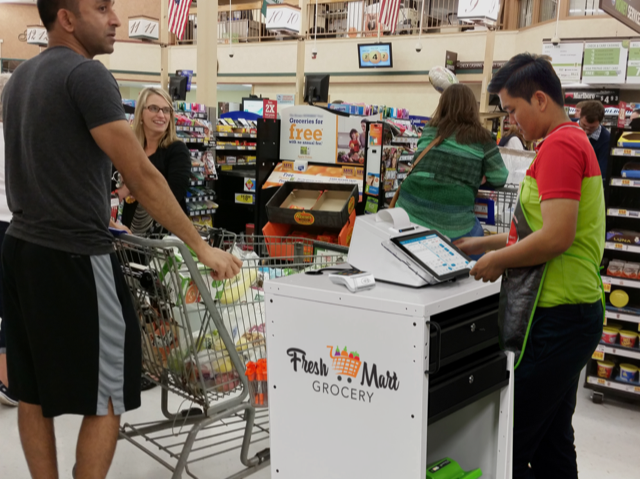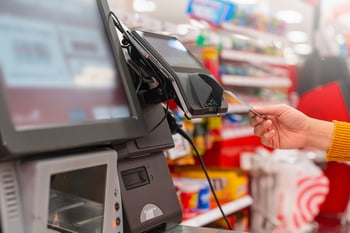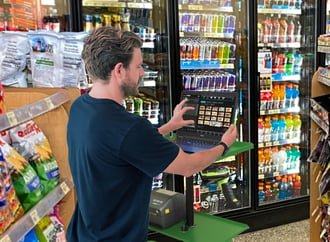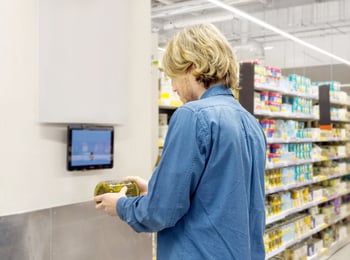
Grocery stores provide an essential service, one that isn’t going to disappear anytime soon. After all, everyone needs to eat. But how those services are delivered and the way grocery retail outlets operate is changing dramatically.
“Retail media” is a term that’s increasingly used in the food and grocery sector, and smart carts are incentivizing shoppers to return to grocery stores and interact with their grocers and products in all kinds of new ways. These smart carts provide better personalization, an easier shopping experience, and shorten checkout lines so employees can focus on curating a quality customer service experience.
Competition and Complexity in the Grocery Retail Market
The grocery industry has become increasingly competitive and complex. Supermarket News reports that these once family-owned markets have evolved into international mega-chains, with some corporations owning upwards of 3,000 stores that carry 100,000 products or more.
The evolution of this industry has happened for several reasons. Businesses have taken advantage of economies of scale to serve the needs and desires of a consumer base that wants a combination of choice and value.
To remain competitive and deliver the best possible customer experience, retail grocers have started taking advantage of powerful technology innovations. The additional benefit of innovation is that technology helps these corporations address other challenges like staffing shortages, inflation, and supply chain disruptions that can impact business in the short and long term.
Ways Mobile Workstations Are Shaping Grocery Retail
According to a recent study by Deloitte, grocers are creating more value by changing how they employ labor and execute operations within their stores. In a survey of grocery retail executives, some of the technology-inspired changes coming to a store near you soon will include things like frictionless checkout and hyper-personalized shopping experiences. Here are some of the ways mobile workstations are making these innovations happen in grocery retail.
Self-Checkout Options
 Gone are the days when customers were willing to wait in long lines so they could watch a cashier scan and weigh each item before cramming the meat into the same bags with the cleaning supplies. Mobile self-check-out has become popular in grocery stores and other retail outlets because it gives control back to the consumers.
Gone are the days when customers were willing to wait in long lines so they could watch a cashier scan and weigh each item before cramming the meat into the same bags with the cleaning supplies. Mobile self-check-out has become popular in grocery stores and other retail outlets because it gives control back to the consumers.
When done properly, mobile checkout is faster, more efficient, and safer than its traditional alternative. And because mobile checkout takes this time-consuming and repetitive task away from employees, it frees them up to handle other matters like customer service.
Convenient In-Store Ordering
Customers aren’t crazy about having to jockey for positions at deli and bakery counters and then shout their orders when their numbers get called. It’s an inefficient process and one ripe for all sorts of errors.
Now, consumers can use mobile workstations instead to place digital orders for the exact items they need. This helps them bypass the line so they can continue shopping while the order is prepared. Then, customers can pick up their products before checking out.
Smart Carts for Consumers
 Shopping for groceries is something just about everyone has to do. In fact, the average consumer goes grocery shopping about eight times per month, according to figures from Drive Research. Unfortunately, most don’t enjoy the activity. While some consumers have begun using online apps for grocery delivery, they still head to retail stores for things like fresh vegetables, fruits, deli, and meat items. Grocery stores are trying to make the process more personalized with things like “smart carts.”
Shopping for groceries is something just about everyone has to do. In fact, the average consumer goes grocery shopping about eight times per month, according to figures from Drive Research. Unfortunately, most don’t enjoy the activity. While some consumers have begun using online apps for grocery delivery, they still head to retail stores for things like fresh vegetables, fruits, deli, and meat items. Grocery stores are trying to make the process more personalized with things like “smart carts.”
Smart carts offer customers a variety of convenient and personalized features. For example, customers can view personalized coupons on the shopping cart and get directions to the items they want within the store. A smart cart can also scan items using RFID tags as they’re placed in the cart, enabling touch-free checkout when leaving the store.
Modern Price-Checkers
 Even if your grocery store doesn’t have smart grocery carts, it can implement technology solutions to help customers get the best possible experience. For example, in-aisle price checkers save grocery stores and customers time and frustration.
Even if your grocery store doesn’t have smart grocery carts, it can implement technology solutions to help customers get the best possible experience. For example, in-aisle price checkers save grocery stores and customers time and frustration.
When grocery prices change due to sales or permanent reductions, these systems can automatically reflect those changes. These smart product discovery kiosks can also provide valuable information to consumers, such as product nutrition, ingredient lists, and allergy information. They can offer current promotional information as well as provide recommendations for recipes and pairings.
Automation in Inventory Management
Robots are becoming useful in a wide variety of industries, such as warehousing, hospitality, and even the medical field. They also have practical applications in supermarkets for functions like inventory management.
One of the most time-consuming and error-prone tasks in grocery store is inventory management. Not only does a grocery store need to keep the shelves stocked, but items on the shelves must also be within their “Good Til” dates. Failure to have the proper levels of “fresh” items on grocery store shelves will prompt customers to turn to a competitor for what they need.
Robotics can provide many solutions for inventory management. AI-driven solutions can ensure your prices are always accurate and inventory figures are updated in real time. You can also leverage connected insights, which can help predict demand and even automatically re-order stock.
Mobile workstations and automation are already playing vital roles in the retail grocery industry. These solutions provide a vast array of benefits for both retailers and shoppers. As stores improve efficiency, reduce errors, and cut costs, they also deliver an elevated customer experience, which gives retailers a valuable competitive advantage.

